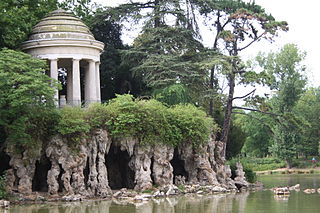
The Jet d'Eau is a large fountain in Geneva, Switzerland and is one of the city's most famous landmarks, being featured on the city's official tourism web site and on the official logo for Geneva's hosting of group stage matches at UEFA Euro 2008. Situated where Lake Geneva exits as the Rhône, it is visible throughout the city and from the air, even when flying over Geneva at an altitude of ten kilometres (33,000 ft).

Cap-de-la-Madeleine is a former city in Quebec, Canada at the confluence of the Saint-Maurice River and the St. Lawrence River. It was amalgamated into the City of Trois-Rivières in 2002. Population 33,022.

Baie-Saint-Paul is a city in the Province of Quebec, Canada, on the northern shore of the Saint Lawrence River. Baie-Saint-Paul is the seat of Charlevoix Regional County Municipality. The city is situated at the mouth of the Gouffre River. It is known for its art galleries, shops and restaurants.

Thury is a commune in the Yonne department in Bourgogne-Franche-Comté in north-central France, in the natural region of Forterre. Its inhabitants are called Thurycois and Thurycoises.

Bolbec is a commune in the Seine-Maritime department in the Normandy region in northern France. Its inhabitants are called Bolbécais or Bolbécaises.
Saintes is a commune and historic town in western France, in the Charente-Maritime department of which it is a sub-prefecture, in Nouvelle-Aquitaine. Its inhabitants are called Saintaises and Saintais. Saintes is the second-largest city in Charente-Maritime, with 26,470 inhabitants in 2008. The city's immediate surroundings form the second-most populous metropolitan area in the department, with 56,598 inhabitants. While a majority of the surrounding landscape consists of fertile, productive fields, a significant minority of the region remains forested, its natural state.

Tonnerre is a commune in the Yonne department in Bourgogne-Franche-Comté in north-central France.

Bertangles is a commune in the Somme department in Hauts-de-France in northern France.
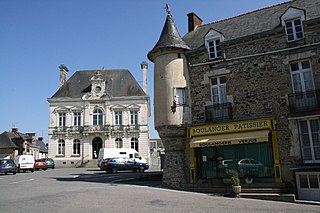
Janzé is a commune in the Ille-et-Vilaine department in Brittany in northwestern France. It is also the seat of the Canton of Janzé. The inhabitants of Janzé are called Janzéens in French.
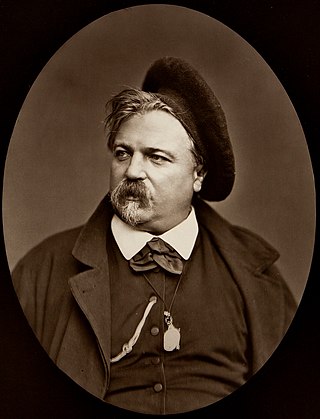
Alfred Grévin was a 19th-century caricaturist, best known during his lifetime for his caricature silhouettes of contemporary Parisian women. He was also a sculptor, cartoonist, and designed costumes and sets for popular theater.
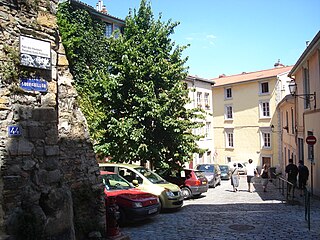
The Montée du Gourguillon is an old street in the 5th arrondissement of Lyon, France, on the hill of Fourvière, between the Saint-Jean and Saint-Just quarters. Montée translates in English to the nouns "climb" or "rise " and is given to a number of steep streets. The ancient Roman settlement of Lugdunum was established here in 43 BC. The montée du Gourguillon begins at the Place de la Trinité and ascends to the rue des Farges. Fourvière is known as "the hill that prays" because the Basilica of Notre-Dame de Fourvière, several convents, and the Archbishop's residence are located there. The street belongs to a zone classified by UNESCO as a World Heritage Site.
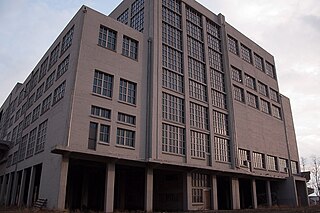
Triage-Lavoir de Péronnes is a former coal washing facility that was built with the help of the Marshall Plan in 1954. It was built for the demand of the coal industry to process the coal coming from the mines of Péronnes, Ressaix and Trivières. It was capable processing over 3,000 tons of coal daily. In 1969 the nearby coal mines in Saint-Albert and Sint-Margriete were closed, which caused Triage-Lavoir to become useless, and it was closed down after only 15 years of active operation. Immediately after closing the facility, all the machines and equipment were removed and the facility stayed abandoned for over 3 decades.

The Fontaine de Vaucluse (French pronunciation:[fɔ̃tɛndəvoklyz]) is a karst spring in the commune of Fontaine-de-Vaucluse, France. It is the largest karst spring in metropolitan France by flow and fifth largest in the world, with annual output of 630,000,000 to 700,000,000 cubic metres (2.2×1010 to 2.5×1010 cu ft) of water. The spring is the prime example in hydrogeology of a "Vaucluse spring". It is the source of the Sorgue.

The Louvain-la-Neuve Cyclotron is a brutalist architectural complex of the University of Louvain built from 1970 to 1972 in Louvain-la-Neuve, Walloon Brabant, Belgium, notably holding UCLouvain's CYCLONE particle accelerators. It is the first building completed by the university when it moved following the Leuven crisis and was the largest cyclotron in Europe at the time of its construction. The Louvain Cyclotron can also refer to Belgium's first cyclotron built in Louvain (Leuven) in 1947, which was replaced by the Louvain-la-Neuve center.

D'Iberville Street is a north-south thoroughfare of Montreal.
Princess Marie-Hermine Antoinette Hermine de Clermont-Tonnerre was a French socialite, stylist, etiquette writer and actress. She was member of the House of Clermont-Tonnerre, a French noble family.

The Mikvahof Strasbourg is a historic site in Strasbourg, in the French department of Bas-Rhin.

The Acqua Tignese is a stream in the Haute-Corse department of the Corsica region that has its mouth north of Cap Corse, in the Ligurian Sea.

The Algemene Spaar- en Lijfrentekas / Caisse générale d'épargne et de retraite was a major Belgian public bank, originally created in 1850 as a pension institution. It was acquired in stages between 1993 and 1998 by Fortis Group. In 1996 it took over Société Nationale de Crédit à l'Industrie (SNCI), another Belgian public bank. In 1999 Fortis merged it with Generale Bank and other operations to form Fortis Bank, which in turn was integrated from 2009 into BNP Paribas.







